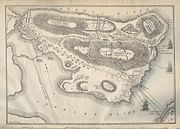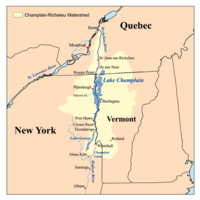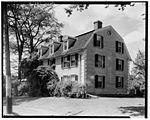
Benjamin Ruggles Woodbridge
Encyclopedia



South Hadley, Massachusetts
South Hadley is a town in Hampshire County, Massachusetts, United States. The population was 17,514 at the 2010 census. It is part of the Springfield, Massachusetts Metropolitan Statistical Area....
, practiced medicine and law, was a colonel in the Massachusetts militia
Massachusetts militia
Militia of the Colony and later Commonwealth of Massachusetts.-List of Massachusetts militia units of the American Revolution:*Ancient and Honorable Artillery Company of Massachusetts *Cogswell's Regiment of Militia...
during the American Revolutionary War
American Revolutionary War
The American Revolutionary War , the American War of Independence, or simply the Revolutionary War, began as a war between the Kingdom of Great Britain and thirteen British colonies in North America, and ended in a global war between several European great powers.The war was the result of the...
, and was a commander at the Battle of Bunker Hill
Battle of Bunker Hill
The Battle of Bunker Hill took place on June 17, 1775, mostly on and around Breed's Hill, during the Siege of Boston early in the American Revolutionary War...
. He was also a farmer, and he owned a rum still, a wood lot, a grazing meadow, and a mill, and came to be the wealthiest man in the town. Colonel Woodbridge was a member of the Massachusetts legislature for many years. Woodbridge was unmarried, and raised his nephew Theodore Strong, as his own son. Benjamin Ruggles Woodbridge died in 1819 at the age of 80. He is sometimes referred to as Ruggles Woodbridge or Benjamin Woodbridge.
Battle of Bunker Hill
Col. Woodbridge entered service on April 20, 1775, the day immediately following the Battles of Lexington and ConcordBattles of Lexington and Concord
The Battles of Lexington and Concord were the first military engagements of the American Revolutionary War. They were fought on April 19, 1775, in Middlesex County, Province of Massachusetts Bay, within the towns of Lexington, Concord, Lincoln, Menotomy , and Cambridge, near Boston...
. He commanded a regiment of Minutemen
Minutemen
Minutemen were members of teams of select men from the American colonial partisan militia during the American Revolutionary War. They provided a highly mobile, rapidly deployed force that allowed the colonies to respond immediately to war threats, hence the name.The minutemen were among the first...
, which was organized into Woodbridge's (25th) Regiment
Woodbridge's Regiment of Militia
Woodbridge's Regiment of Militia, also known as the "1st Hampshire County Militia Regiment" and "Woodbridge's Regiment" and "The 25th Regiment of Foot"...
. During the Siege of Boston
Siege of Boston
The Siege of Boston was the opening phase of the American Revolutionary War, in which New England militiamen—who later became part of the Continental Army—surrounded the town of Boston, Massachusetts, to prevent movement by the British Army garrisoned within...
, Woodbridge's regiment was based at Cambridge
Cambridge, Massachusetts
Cambridge is a city in Middlesex County, Massachusetts, United States, in the Greater Boston area. It was named in honor of the University of Cambridge in England, an important center of the Puritan theology embraced by the town's founders. Cambridge is home to two of the world's most prominent...
near Boston, and participated in the Battle of Bunker Hill
Battle of Bunker Hill
The Battle of Bunker Hill took place on June 17, 1775, mostly on and around Breed's Hill, during the Siege of Boston early in the American Revolutionary War...
, the first large-scale battle of the war. During the Siege of Boston and the Battle of Bunker Hill, Abijah Brown served as lieutenant colonel to Woodbridge, and William Stacy
William Stacy
William Stacy was an officer of the Continental Army during the American Revolutionary War, and a pioneer to the Ohio Country...
served as major.
On June 17, 1775, immediately prior to the Battle of Bunker Hill
Battle of Bunker Hill
The Battle of Bunker Hill took place on June 17, 1775, mostly on and around Breed's Hill, during the Siege of Boston early in the American Revolutionary War...
, Woodbridge marched his regiment in good order from the mainland across the Charlestown
Charlestown, Massachusetts
Charlestown is a neighborhood of Boston, Massachusetts, United States, and is located on a peninsula north of downtown Boston. Charlestown was originally a separate town and the first capital of the Massachusetts Bay Colony; it became a city in 1847 and was annexed by Boston on January 5, 1874...
Neck, an isthmus
Isthmus
An isthmus is a narrow strip of land connecting two larger land areas usually with waterforms on either side.Canals are often built through isthmuses where they may be particularly advantageous to create a shortcut for marine transportation...
connecting the mainland with the Charlestown Peninsula
Peninsula
A peninsula is a piece of land that is bordered by water on three sides but connected to mainland. In many Germanic and Celtic languages and also in Baltic, Slavic and Hungarian, peninsulas are called "half-islands"....
and the battlefield. The regiment was under fire from British naval vessels as they crossed the neck to reinforce Col. William Prescott
William Prescott
William Prescott was an American colonel in the Revolutionary War who commanded the rebel forces in the Battle of Bunker Hill...
's regiment; British vessels were bombarding the battlefield and the Charlestown Neck prior to the assault of the British troops. General Israel Putnam
Israel Putnam
Israel Putnam was an American army general and Freemason who fought with distinction at the Battle of Bunker Hill during the American Revolutionary War...
, riding his horse from the battlefield to the neck, met Woodbridge’s regiment and urged them to run to the battlefield. The rush to battle caused confusion and separation of Woodbridge’s men as they arrived at the field of action. Parts of the regiment engaged and joined the battle.
Woodbridge's regiment
Woodbridge's Regiment of Militia
Woodbridge's Regiment of Militia, also known as the "1st Hampshire County Militia Regiment" and "Woodbridge's Regiment" and "The 25th Regiment of Foot"...
arrived at Bunker Hill immediately prior to the battle. A company from Woodbridge’s regiment deployed on the right flank, and a portion of the regiment joined Colonel Prescott's regiment
7th Continental Regiment
The 7th Continental Regiment was raised April 23, 1775 as a Massachusetts militia Regiment at Cambridge, Massachusetts under Colonel William Prescott. The regiment would join the Continental Army in June 1775. The regiment saw action during the Siege of Boston and the New York Campaign...
at the redoubt
Redoubt
A redoubt is a fort or fort system usually consisting of an enclosed defensive emplacement outside a larger fort, usually relying on earthworks, though others are constructed of stone or brick. It is meant to protect soldiers outside the main defensive line and can be a permanent structure or a...
and breastwork
Breastwork (fortification)
A breastwork is a fortification. The term is usually applied to temporary fortifications, often an earthwork thrown up to breast height to provide protection to defenders firing over it from a standing position...
on the hill. Woodbridge's regiment “was not commissioned, and there are few details of it, or of its officers, in the accounts of the battle.” Reports of the battle indicate that the American defenders on the right flank fought valiantly from behind what cover they could find. The men at the redoubt and breastwork fought until they had no more bullets, finally fighting with the butts of their guns, rocks, and their bare hands. It is also reported that Woodbridge’s regiment covered the retreat of the Continental Army
Continental Army
The Continental Army was formed after the outbreak of the American Revolutionary War by the colonies that became the United States of America. Established by a resolution of the Continental Congress on June 14, 1775, it was created to coordinate the military efforts of the Thirteen Colonies in...
across the Charleston
Charlestown, Massachusetts
Charlestown is a neighborhood of Boston, Massachusetts, United States, and is located on a peninsula north of downtown Boston. Charlestown was originally a separate town and the first capital of the Massachusetts Bay Colony; it became a city in 1847 and was annexed by Boston on January 5, 1874...
Neck to the mainland after the hill was taken by the British.
Lechmere’s Point
Woodbridge’s regiment was actively involved throughout the Siege of BostonSiege of Boston
The Siege of Boston was the opening phase of the American Revolutionary War, in which New England militiamen—who later became part of the Continental Army—surrounded the town of Boston, Massachusetts, to prevent movement by the British Army garrisoned within...
. On November 11, 1775, George Washington
George Washington
George Washington was the dominant military and political leader of the new United States of America from 1775 to 1799. He led the American victory over Great Britain in the American Revolutionary War as commander-in-chief of the Continental Army from 1775 to 1783, and presided over the writing of...
wrote to Congress of an incident during the siege, in which Col. Woodbridge and part of his regiment
Woodbridge's Regiment of Militia
Woodbridge's Regiment of Militia, also known as the "1st Hampshire County Militia Regiment" and "Woodbridge's Regiment" and "The 25th Regiment of Foot"...
joined with Col. William Thompson’s
William Thompson (general)
William Thompson was a soldier from Pennsylvania and a brigadier general in the Continental Army during the American Revolutionary War.Thompson was born in Ireland and emigrated to Carlisle, Pennsylvania...
Pennsylvania regiment
1st Pennsylvania Regiment
The 1st Pennsylvania Regiment, also known as the Pennsylvania Rifle Regiment and 1st Continental Regiment, was raised under the command of Colonel William Thompson for service in the Continental Army.-History:...
, defending against a British landing at Lechmere’s Point
Lechmere Square
Lechmere Square is located at the intersection of Cambridge Street and First Street in East Cambridge, Massachusetts. It was originally named for the Colonial-era landowner Richard Lechmere, a Loyalist who returned to England at the beginning of the American Revolution. His lands were later seized...
, and “gallantly waded through the water, and soon obliged the enemy to embark under cover of a man-of-war…”
Pawlet Expedition
Colonel Woodbridge served under General Benjamin LincolnBenjamin Lincoln
Benjamin Lincoln was an American army officer. He served as a major general in the Continental Army during the American Revolutionary War...
during the Pawlet Expedition of September 1777. A revolutionary force gathered at Pawlet, Vermont
Pawlet, Vermont
Pawlet is a town in Rutland County, Vermont, United States. The population was 1,477 at the 2010 census.-Geography:According to the United States Census Bureau, the town has a total area of , of which 0.02% is water.Pawlet is a rural farming town...
for a three-pronged attack of 500 men each against Fort Ticonderoga
Fort Ticonderoga
Fort Ticonderoga, formerly Fort Carillon, is a large 18th-century fort built by the Canadians and the French at a narrows near the south end of Lake Champlain in upstate New York in the United States...
. Col. John Brown
John Brown of Pittsfield
Colonel John Brown , often known as John Brown of Pittsfield because of his common name, was a Patriot, spy, soldier, and military leader, in the American Revolutionary War...
led a force against the outposts of Ticonderoga, Col. Samuel Johnson led a diversionary force against Mount Independence
Mount Independence
Mount Independence is a high hill on the Vermont side of Lake Champlain, in the northeastern United States.It is a Vermont State Historic Site and was the site of Fort Independence, an American revolutionary war fortification built opposite Fort Ticonderoga...
across Lake Champlain
Lake Champlain
Lake Champlain is a natural, freshwater lake in North America, located mainly within the borders of the United States but partially situated across the Canada—United States border in the Canadian province of Quebec.The New York portion of the Champlain Valley includes the eastern portions of...
from Ticonderoga, and Col. Woodbridge led a covering force to Skenesborough (now known as Whitehall
Whitehall (village), New York
Whitehall is a village located in the town of Whitehall in Washington County, New York, USA. It is part of the Glens Falls Metropolitan Statistical Area...
) at the south end of Lake Champlain. Col. Brown’s attack successfully crippled the British position at Ticonderoga, preventing supplies or reinforcements from reaching General John Burgoyne
John Burgoyne
General John Burgoyne was a British army officer, politician and dramatist. He first saw action during the Seven Years' War when he participated in several battles, mostly notably during the Portugal Campaign of 1762....
, who surrendered the following month at Saratoga.
Later life
Benjamin Ruggles Woodbridge presented a bell to his parish in South Hadley, MassachusettsSouth Hadley, Massachusetts
South Hadley is a town in Hampshire County, Massachusetts, United States. The population was 17,514 at the 2010 census. It is part of the Springfield, Massachusetts Metropolitan Statistical Area....
. Tradition says that Colonel Woodbridge went to the foundry and cast fifty silver dollars into the molten metal to give the bell a silvery tone. The memory of Colonel Woodbridge was honored with the following quotes:
The duties of his command he performed in a manner highly creditable to himself and to the advantage of the cause which he had espoused. At the call of his country during the Revolutionary War, he often and promptly exerted his military talents and ardor in vindicating the rights, the independence, and laws of his country.
The name of Ruggles Woodbridge, already mentioned, is among the proudest associations of the town [South Hadley]. He was a man of great wealth, was a Colonel in the Revolution, and for many years exercised a commanding influence in the town.
The Woodbridge home, known as ‘Sycamores’, served as a dormitory for Mount Holyoke College
Mount Holyoke College
Mount Holyoke College is a liberal arts college for women in South Hadley, Massachusetts. It was the first member of the Seven Sisters colleges, and served as a model for some of the others...
(South Hadley, MA
South Hadley, Massachusetts
South Hadley is a town in Hampshire County, Massachusetts, United States. The population was 17,514 at the 2010 census. It is part of the Springfield, Massachusetts Metropolitan Statistical Area....
) from 1915-1970. The mansion, built in 1788 by Colonel Woodbridge, is on the National Register of Historic Places
National Register of Historic Places
The National Register of Historic Places is the United States government's official list of districts, sites, buildings, structures, and objects deemed worthy of preservation...
.

